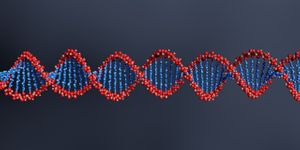Revealing the Impact of Drastic RNA Editing Changes in Schizophrenia
Schizophrenia is a mental illness characterized by persistent delusions or hallucinations, changes in a person's perception of reality, disorganized thinking, and other disruptions that can affect many aspects of an individual's life. There has been no single cause identified for the disease, and it's been suggested that factors in the environment and the genome may lead to schizophrenia. As many as one in 300 people around the world may have schizophrenia, and patients are often discriminated against. Better, more effective treatments for the disorder are desperately needed.
Researchers have known that in schizophrenia patients, RNA editing is drastically modified. When genes are active, they are transcribed into messenger RNA molecules, which get processed and edited in various ways, and are often then translated into proteins. RNA editing is a crucial process that can have a significant impact on how genes and proteins are expressed. Adenosine deaminase (ADAR) enzymes play a vital role in RNA editing by converting adenosine nucleotides to inosine.
In a new study reported in Science Advances, scientists analyzed the brains of deceased schizophrenia patients to assess how RNA editing was altered compared to unaffected brains. In this cohort, which included patients of European descent, there was an overall reduction in RNA editing. In all, there were 26,841 unique places in which editing had changed. Genes in which RNA editing was reduced were found to be related to some brain functions such as the guidance of motor neuron axons and synaptic transmission.
The study authors suggested that a huge number of biological processes could be impacted by this widespread RNA editing reduction. The research supported previous work that has suggested that increases in ADAR3 expression, which is known to reduce RNA editing, also affect the immune system. ADAR2 also seems to be influencing the process; the study found that increased ADAR2 expression increased RNA editing. They also showed that the altered RNA editing was likely impacting mitochondrial function.
A gene called mitofusin 1 (MFN1) was found to be significantly affected by this reduction in RNA editing. MFN1 encodes for a protein that sits in the mitochondrial membrane, and plays an essential role in mitochondrial fusion. If fusion is disrupted, mitochondria repair is affected, which may lead to alterations in the levels of transcribed RNA. Thus, schizophrenia may be related to an overall lowering of RNA editing and changes in mitochondrial function. Mitochondrial hyperfusion leading to apoptosis may be occurring in the brains of schizophrenic patients, but more research will be needed to test that hypothesis.
The study authors also assessed another cohort of African American schizophrenia patients. In this group, RNA editing was actually increased. This showed that in future studies, scientists should investigate whether there are mechanistic differences in the control of RNA editing schizophrenic patients from diverse ancestral populations. The authors also noted that it highlights the importance of including patients from a spectrum of ancestries in disease research.
Source: Science Advances









